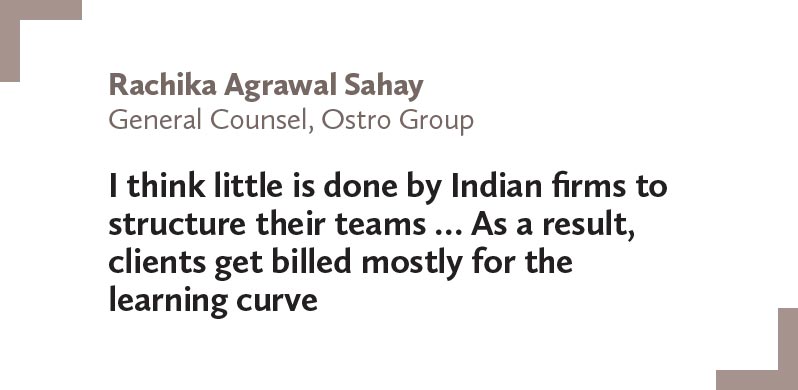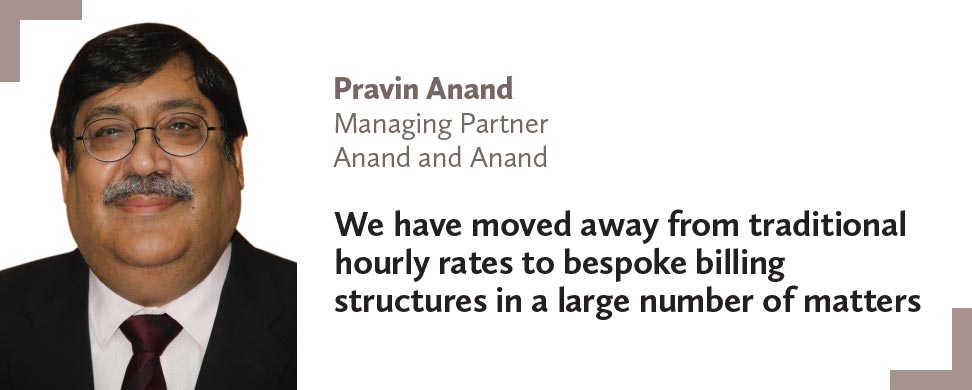India Business Law Journal’s 2017 billing rates survey finds that hourly rates fall across the board as lawyers face cut-throat competition, undercutting and high demand for alternative fee structures. Vandana Chatlani reports
India’s corporate legal sphere is spinning fast, racing to keep up with regulatory rhythms and legal labyrinths. The competition has never been stiffer with law firms of all shapes and sizes expanding operations, promoting specializations and getting to grips with technology to streamline their offerings. For general counsel, there has never been more choice, particularly as both veterans and young hungry lawyers leave established firms to go solo. With minimal overheads, these practitioners can offer quality advice at a fraction of the cost. But with competition so fierce, and a burning desire to seize prestigious mandates, even the largest firms are willing to drop their prices considerably.
“There is increased competition and major undercutting of fees,” says Prem Rajani, the managing partner at Rajani Associates. “Even when clients agree to a fee or sign mandate letters, it takes a while for them to release the payment.”
As general counsel assume greater responsibility, authority and influence, they have become skilled purchasers of legal services. Some also have insider knowledge of what it is like to work on the other side of the table, having been in private practice before. Shuva Mandal and Priya Mehra are good examples. Mandal, the new general counsel of Tata, worked previously with Shardul Amarchand Mangaldas & Co and AZB & Partners, while Mehra, the new general counsel at Indigo Airlines, has practised with AZB, Jones Day and Gibson Dunn & Crutcher. Such lawyers know exactly how to buy legal services, having sold them before. They understand the inner workings of law firms, how to maximize efficiency, demand adequate partner time and negotiate a fee structure that doesn’t spiral out of control.
Rachika Agrawal Sahay, who worked at Trilegal early on in her career, is now the general counsel at Ostro Group. “I think little is done by Indian firms to structure their teams,” she says. “As a result, clients get billed mostly for the learning curve. That’s why most clients look for capped fees, and matters that cannot be capped such as negotiations, become a pain point between clients and the law firm.”
This tight rein on legal budgets in-house has forced law firms to rethink their pricing strategies. Many recognize that because in-house legal departments are continuously growing, general counsel can afford to spend less on outside counsel and be decisive about what is outsourced, to whom and at what cost. As a result, several law firms have taken a step back from the conventional hourly billing model to offer more flexibility and predictability with regards to legal fees.
“We have moved away from traditional hourly rates to bespoke billing structures in a large number of matters,” says Pravin Anand, the managing partner at Anand and Anand, and a loyal supporter of India Business Law Journal’s billing rates survey. He explains that the trademark and patent departments, for example, work on fixed rates per activity rather than billing by the hour. He says that the firm’s use of hourly billing has not disappeared altogether, but explains that this model is normally used for matters such as large patent litigation, which is based on a blended rate.
Anand Prasad, who set up Chambers of Anand Prasad after leaving Trilegal earlier this year, has moved to “value-based billing” instead of the normal hourly rates and has “no definite fee structure”.
“Clients are moving towards lump sum fee arrangements instead of hourly rates,” says Seema Jhingan, a partner at LexCounsel. “Our firm has signed many such fee arrangements over the last year.”
Rajesh Ramanathan, a partner at Factum Law in Chennai, agrees with this. “The hourly billing system has reduced considerably,” he says, estimating that only 25% of matters at his firm are billed using this model. Other firms which only occasionally use the hourly rate are Altacit Global, Athena Law Associates and ROYZZ & Co. “Only 10% of our billing is based on unforeseen circumstances, which is without a pre-estimated cap,” says ROYZZ managing partner Mahua Roy Chowdhury. Nasikwala Law Office, meanwhile, has done away with hourly billing altogether.
Fee fever
In this landscape of tightly controlled legal budgets, India Business Law Journal presents its 11th annual billing rates survey. As always, the survey is highly anticipated by in-house lawyers in India and beyond. “I really appreciate the topic chosen, which concerns all corporate counsel,” says Nandan Kumar Baranwal, the senior legal manager and company secretary at Felguera Gruas India in Vishakapatnam. “It is much discussed internally by various business unit heads and also in the boardroom.”
The survey is our largest to date, with an analysis based on 82 participating firms of between three and 630 lawyers from Ahmedabad, Bengaluru, Chandigarh, Chennai, Cochin, Delhi, Hyderabad, Kolkata and Mumbai. We highlight our findings through a series of infographics and present the full table of billing rates below (for subscribers only).
You must be a
subscribersubscribersubscribersubscriber
to read this content, please
subscribesubscribesubscribesubscribe
today.
For group subscribers, please click here to access.
Interested in group subscription? Please contact us.
你需要登录去解锁本文内容。欢迎注册账号。如果想阅读月刊所有文章,欢迎成为我们的订阅会员成为我们的订阅会员。
What are the alternatives?
A sample of different billing models offered by Indian law firms
IC Universal Legal: Blended fee model – a uniform charge-out rate applies for the entire team irrespective of seniority of firm member involved.
Chadha & Chadha: A fixed pricing model is widely used as transparency matters the most to us and our clients. Another alternative billing arrangement is the retainership model. For long-term clients with routine and predictable business, this model seems a better fit.
Nasikwala Law Office: For court matters, we charge by effective appearance, which means an appearance where a matter is argued for at least 10-15 minutes. In the Indian courts there are numerous times when matters either do not reach before a court closes or an adjournment is granted. Sometimes a matter scheduled for the morning is held back and heard after 3pm. We are present when all the foregoing occurs. These delays occur more frequently than one desires and we term them “non-effective appearances” and do not charge for them (unlike most counsel who do).
Brus Chambers: There are very few law firms that are practising ship arrest work. Clients are billed on fixed fees (stage wise) until arrest of the ship. In most cases they pay the requested fee in advance.
Clove Legal: Retainer model – where the volume of work is substantial on a regular basis and for a specific type of work (such as commercial contracts, intellectual property-related such as licensing contracts, general consultancy, legal notices, etc.)
Keeping legal costs low
In-house counsel share tips on money management
Engage external counsel based on their expertise in the required domain area and not on their fame – Vidya Subramanian, deputy general manager of IPR, Reliance Life Sciences
First understand the nature of expertise of the firm you would like to engage. Do not settle on one firm before obtaining fee quotes from at least two or three similar sized firms. Extensively discuss the advice you will require on a regular basis and in the future – Nandan Kumar
Baranwal, senior legal manager and company secretary, Felguera Gruas India
In-house counsel should first try to negotiate fixed fees based on the assignment and define timelines and expectations clearly. In the few instances where fixed fees cannot be agreed, it would be prudent to agree on a blended rate where higher partner involvement is possible. Additionally, a cap of billing can be agreed and hours over that cap may have a further discount since the law firm will also have economies of scale. It is important when billed by the hour to monitor the hours spent on a weekly basis against the work done and the cap agreed – Nitin Mittal, head of legal, compliance and company secretary, Philips Lighting India
Be clear in your expectations and requirements and get a confirmation that the external counsel has understood this. Having a detailed case of opinion ready with all the supporting documents helps in reducing the briefing and understanding time. Also, clearly point out and/or mark the relevant clauses that you would like the law firm to review – Gaurav Khanna, deputy general manager, Tata Realty
Hourly billing only leads to an in-house lawyer losing control over legal spend. Concurrence of what is the right amount is unlikely to happen. It is important to bifurcate matters that can be managed internally and those that are required to be outsourced (such as land diligences and matters requiring expert domain knowledge). While legal spend is a necessary evil, it can be managed judiciously – Rachika Agrawal Sahay, general counsel, Ostro Group





























